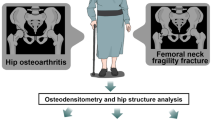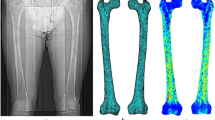Abstract
Hip fracture is a kind of osteoporotic fractures in elderly patients. Its important monitoring indicator is to measure bone mineral density (BMD) using DXA. The stress characteristics and material distribution in different parts of the bones can be well simulated by three-dimensional finite element analysis. Our previous studies have demonstrated a linear positive correlation between clinical BMD and the density of three-dimensional finite element model of the femur. However, the correlation between the density variation between intertrochanteric region and collum femoris region of the model and the fracture site has not been studied yet. The present study intends to investigate whether the regional difference in the density of three-dimensional finite element model of the femur can be used to predict hip fracture site in elderly females. The CT data of both hip joints were collected from 16 cases of elderly female patients with hip fractures. Mimics 15.01 software was used to reconstruct the model of proximal femur on the healthy side. Ten kinds of material properties were assigned. In Abaqus 6.12 software, the collum femoris region and intertrochanteric region were, respectively, drawn for calculating the corresponding regional density of the model, followed by prediction of hip fracture site and final comparison with factual fracture site. The intertrochanteric region/collum femoris region density was [(1.20 ± 0.02) × 106] on the fracture site and [(1.22 ± 0.03) × 106] on the non-fracture site, and the difference was statistically significant (P = 0.03). Among 16 established models of proximal femur on the healthy side, 14 models were consistent with the actual fracture sites, one model was inconsistent, and one model was unpredictable, with the coincidence rate of 87.5 %. The intertrochanteric region or collum femoris region with lower BMD is more prone to hip fracture of the type on the corresponding site.







Similar content being viewed by others
References
Gullberg, B., Johnell, O., & Kanis, J. A. (1997). World-wide projections for hip fracture. Osteoporosis International, 7(5), 407–413.
Keene, G. S., Parker, M. J., & Pryor, G. A. (1993). Mortality and morbidity after hip fractures. BMJ, 307(6914), 1248–1250.
Braithwaite, R. S., Col, N. F., & Wong, J. B. (2003). Estimating hip fracture morbidity, mortality and costs. Journal of the American Geriatrics Society, 51(3), 364–370.
Koivumäki, J. E. M., Thevenot, J., Pulkkinen, P., Kuhn, V., Link, T. M., Eckstein, F., & Jämsä, T. (2012). Ct-based finite element models can be used to estimate experimentally measured failure loads in the proximal femur. Bone, 50(4), 824–829.
Van den Munckhof, S., & Zadpoor, A. A. (2014). How accurately can we predict the fracture load of the proximal femur using finite element models? Clinical Biomechanics, 29(4), 373–380. (Bristol, Avon).
Schileo, E., Balistreri, L., Grassi, L., Cristofolini, L., & Taddei, F. (2014). To what extent can linear finite element models of human femora predict failure under stance and fall loading configurations? Journal of Biomechanics, 47, 3584–3589. pii: S0021-9290(14)00460-6.
Body, J. J. (2011). How to manage postmenopausal osteoporosis? Acta Clinica Belgica, 66(6), 443–447.
Jade, S., Tamvada, K. H., Strait, D. S., & Grosse, I. R. (2014). Finite element analysis of a femur to deconstruct the paradox of bone curvature. Journal of Theoretical Biology, 21(341), 53–63.
Liu, C. C., Xing, W. Z., Zhang, Y. X., Pan, Z. H., & Feng, W. L. (2014). Three-dimensional finite element analysis and comparison of a new intramedullary fixation with interlocking intramedullary nail. Cell biochemistry and biophysics.
Keyak, J. H., Rossi, S. A., Jones, K. A., Les, C. M., & Skinner, H. B. (2001). Prediction of fracture location in the proximal femur using finite element models. Medical Engineering & Physics, 23(9), 657–664.
Lefauveau, P., & FardeIlone, P. (2004). Extraskeletal risk factors for fractures of the proximal femur. Joint Bone Spine, 71(1), 14–17.
Wachter, N. J., Augat, P., Hoellen, I. P., Krischak, G. D., Sarkar, M. R., Mentzel, M., et al. (2001). Predictive value of Singh index and bone mineral density measured by quantitative computed tomography in determining the local cancellous bone quality of the proximal femur. Clinical Biomechanics, 16(3), 257–262. (Bristol, Avon).
Lotz, J. C., Cheal, E. J., & Hayes, W. C. (1991). Fracture prediction for the proximal femur using finite element models: Part I: Linear analysis. Journal of Biomechanical Engineering, 113(4), 353–360.
Cauley, J. A., Lui, L.-Y., Genant, H. K., & Salamone, L. (2009). Risk factors for severity and type of the hip fracture. Journal of Bone and Mineral Research, 24, 943–955.
Homminga, J., Weinans, H., Gowin, W., et al. (2001). Osteoporosis changes the amount of vertebral trabecular bone at risk of fracture but not the vertebral load distribution. Spine, 26(14), 1555–1561.
Crawford, R. P., Cann, C. E., Keaveny, T. M., et al. (2003). Finite element models predict in vitro vertebral body compressive strength better than quantitative computed tomography. Bone, 33(4), 744–750.
Taylor, W. R., Roland, E., Ploeg, H., et al. (2002). Determination of orthotropic bone elastic constants using FEA and modal analysis. Journal of Biomechanics, 35(6), 767–773.
Campoli, G., Baka, N., Kaptein, B. L., Valstar, E. R., Zachow, S., Weinans, H., & Zadpoor, A. A. (2014). Relationship between the shape and density distribution of the femur and its natural frequencies of vibration. Journal of biomechanics, 47(13), 3334–3343.
Larrosa, M., Gomez, A., Casado, E., Moreno, M., Vázquez, I., Orellana, C., et al. (2012). Hypovitaminosis D as a risk factor of hip fracture severity. Osteoporosis International, 23(2), 607–614.
Acknowledgements
The present study is supported by the fund of Guangdong Provincial Science and Technology Planning Project (No.: KFC110122K08). All used software are provided by Orthopaedic and Traumatology of Traditional Chinese Medicine, a National Key Discipline Laboratory of Guangzhou University of Traditional Chinese Medicine.
Author information
Authors and Affiliations
Corresponding author
Rights and permissions
About this article
Cite this article
Lin, Z.L., Li, P.F., Pang, Z.H. et al. Influence of Regional Difference in Bone Mineral Density on Hip Fracture Site in Elderly Females by Finite Element Analysis. Cell Biochem Biophys 73, 405–412 (2015). https://doi.org/10.1007/s12013-015-0650-4
Published:
Issue Date:
DOI: https://doi.org/10.1007/s12013-015-0650-4




